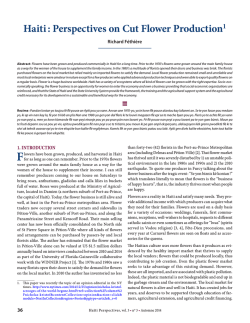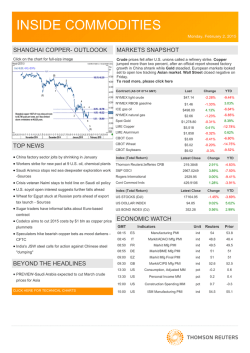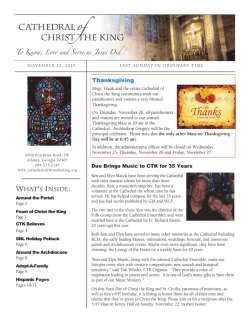
Ariel FARM 16 1
Acta Farm. Bonaerense 16 (1): 37-42 (1997)
Trabajos originales
Recibido el 3 de diciembre de 1996
Aceptado el 24 de febrero de 1997
Partial Characterization of a Milk Clotting Proteinase isolated
from Artichoke (Cynara Scolymus L., Asteraceae)
Berta E. LLORENTE 1 *, Cristina B. BRUlTI 1 ,Claudia L. NATALUCCI 2
y Néstor O. CAFFINI 2
1 Laboratorio de Cultivo de Tejidos Vegetales, Depto. de Cs. Básicas,
Universidad Nacional de Luján, CC 221, 6700 Luján, Argentina.
2 LIPROVE, Depto. de Cs. Biológicas, Facultad de Ciencias Exactas,
Universidad Nacional de La Plata CC 711,1900 La Plata, Argentina
SUMMARY. The presence of proteinases in Cynara scolyrnus L. ("artichoke") has
been investigated by determining the proteolytic and milk clotting activities of crude
extracts of different parts of the inflorescence in various stages of development, as
well as of leaves and roots. Although al1 the preparations showed a certain extent of
proteolytic activity, only those of adult leaves, pappus, and immature and mature
flowers were able to clot milk. The extract of the upper (violet) part of mature flowers
exhibited optimum activity at acid pH values (90% of maximum activity at pH 3.5
5.0) which was strongly inhibited by pepstatine A, suggesting the presence of aspartic
proteinases. This extract had a low thermal stability at temperatures above 45 "C,
which could be a useful property in cheese making process, as it could be quickly inactivated by moderate heating.
RESUMEN. "Caractenzación parcial de una proteinasa coagulante de la leche aislada del
alcaucil (Cynara scolymus L., Asteraceae)". Se ha estudiado la presencia de proteinasas en
el alcaucil (Cynara scolymus L.) midiendo la actividad proteolítica y la capacidad coagulante de la leche de preparaciones crudas de diferentes partes de la inflorescencia en distiritos estadios de desarrollo, así como eii raíces y hojas. Si bien se detecta actividad proteolitica en todas las preparaciones, sólo las de hojas adultas, de papus y de flores irimaduras y
maduras son capaces de coagular la leche. El extracto de la parte superior (violeta) de las
flores maduras exhibe un perfil de pH que es óptimo en la zona ácida (90% de máxima actividad entre pH 3,5 y 5,0), pero la actividad es fuertemente inhibida por pepstatina A, lo
que sugeriría la presencia de una o más proteinasas aspárticas. La estabilidad térmica del
extracto es baja a temperaturas superiores a 45 "C, circunstancia que puede resultar de utilidad en la producción de quesos, ya que la enzima puede ser inactivada a temperaturas
moderadas.
-
INTRODUCTION
Proteolytic enzymes are widely eniployed in food industry for cheese a n d
beer manufacture, tenderization of Ineat, bread manufacture, production of ernulsifiers, a n d other uses 1. The coagulant rnost widely used for cheese inaking is aniKEW WORDS: Artichoke, Asteraceae, Cytlura scolynzus, M i k clotting, Proteinase
PALABRAS CLAVE: Alcaucil, Asteraceae, Cyriaru scolyrnus, Coagulante de la leche,
Proteinasa
*
Corresponding author
ISSN 0326-2383
Llorente, B.E.,
C.B. Bmtti, C.L. Natalucci & N.O. Caffini
mal rennet, extracted from the abdominal mass of young ruminants. However, in
recent years the use of enzymes of the group of acid proteinases from microorganisms has become fairly common, for economic, religious or cultural reasons. Still
more recently, chymosin (the main proteinase of animal rennet) has been produced by microorganisms using recombinant DNA techniques 2 . Shortage of animal rennets, world-wide increase in cheese consumption and continuous growth
of the vegetarian market encouraged researches on proteases from plants sources
that could serve as functional substitutes for chymosin 173,4.
The flowers of cardoon (Cynara cardunculus L.) are traditionally used in the
Mediterranean region for cheese making 4-7. Different species are described for the
genus Cynara, but only C. cardunculus L. is referred to be used in cheese making 8 .
The present paper deals with the presence of milk clotting activity in different organs of the artichoke (Cynara scolymus L., Asteraceae).
MATERIALS AND METHODS
Plant material
Plants of Cynara scolymus C.V.Green Globe in different stages of development were collected in Nogoyá, Entre Ríos Province, Argentina, since October to
December. They were scrupulously cleaned with tap water and divided into different parts: roots, young and adult leaves, midribs, inflorescence stems and leaves,
imniature flowers, receptacles, pappus, and upper part of mature (violet) flowers.
Cm& protek extract
Crude extracts of the different tissues were obtained by homogenising fresh
tissue (10 g) in a blender with cold (-20 "C) acetone (30 ml) in order to obtain an
acetone powder 9. One g of this powder was extracted at 4 "C for-60 min with 50
m1 of 0.1 M potassium phosphate buffer (pH 6.0) containing 5 mM EDTA and 5
mM cysteine, with gentle stirring. The suspension was centrifuged at 16000 x g for
30 min at 4 "C and the precipitate was discarded. The supernatant was collected
and immediately frozen at -20 "C until its analysis.
Pmtein content
Protein concentration was determined according to Bradford
serum albumin was used as standard.
lo.
Bovine
Pmteolytic activity
Caseizz
Proteolytic activity was determined using 0.1 m1 de ensyme solution and 1.1
m1 of 1% (w/v) casein solution (1 g casein was treated with 1.5 m1 of 0.1 M NaOH
and then 100 m1 of 0.1 M potassium phosphate buffer was added; the resulting
suspension was boiled for 20 min, filtered, adjusted to pH 6.0 if necessary and
brought to 100 m1 with distilled water). The reaction mixture was incubated in a
water-bath at 37 "C for 30 min. The reaction was stopped by addition of 1.8 m1 of
5% (w/v) trichloroacetic acid. Blanks were prepared by combining t h e
trichloroacetic acid with the enzyme, then adding the substrate. The tubes were
centrifuged at 4000 x g for 20 min and the absorbance of supernatants was mea-
acta farmacéutica bonaerense - vol. 16 no 1 - año 1997
sured at 280 nm. An arbitrary enzyme unit (U,,> was defined as the amount of enzyme that produces an increase of one absorbance unit per minute in the assay
conditions.
Haemoglobin
When bovine haemoglobin was used, this substrate was prepared by a modification of the Anson procedure 11. The reaction mixture contained 250 p1 of a dilution of the enzyme in a suitable buffer and 1.25 m1 of haemoglobin solution.
The reaction was carried out at 37 OC for 10 min and stopped by the addition of
2.5 m1 of 5 % (w/v) trichloroacetic acid. The mixtures were centrifuged at 4000 x g
for 20 min and the absorbance of supernatants was measured at 280 nm. One unit
of enzyme activity was defined as the amount of enzyme required to cause an unit
increase in absorbance at 280 nm per minute, under the assay conditions.
Azocmein
Azocasein was the substrate employed for inhibition assays with 1,lOphenanthroline, as this inhibitor of metallo-proteases shows high absorbance at
280 nm.. The substrate was prepared by a modified procedure 12 of the Charney &
Tomarelli's technique 13. The reaction mixture containing 250 p1 of 2% azocaseiri
in 0,l M Tris-HC1 (pH 8,O) and 150 p1 of the enzyme extract was incubated at 37
'C. The reaction was stopped by the addition of 1.2 m1 of 10 % trichloroacetic
acid, the mixture was lain down for 15 min and centrifuged at 8000 x g for 3 min.
Then, 1.2 m1 of the supernatant was mixed with 1.4 m1 of 1 M NaOH and the absorbance at 440 nm was measured. o n e unit of enzyme activity was defined as the
amount of enzyme required to cause an unit increase in absorbance at 440 nm per
minute, under the assay conditions.
M ü k clottlng actlvity
Crude extract (0.5 ml) was added to 3 m1 of 10 % (w/v) solution of cow
skimmed milk powder in 0.01 M calcium chloride. Clotting activity was determined at 37 'C. In order to better visualize curd formation, a narrower tube filled
with dilute blue ink was inserted into the test tube. Clotting tilile was determined
by direct observation of flocculation and gel formation against the blue-dye tube.
Controls were prepared by adding extraction buffer to milk solution.
Eflect of lnbibttors
The effect of inhibitors on proteolytic activity was determined by preincubating the protease preparation with the inhibitor at 37 OC for 30 min and the residual
activity estimated on casein or azocasein at pH 6.0. Cystein f5 mM), E-64 (10 (M),
pepstatine A (1 (M), 1,lO-phenanthroline (10 mM), and phenylmethylsulfonyl fluoride (1 mM) were assayed. Controls were prepared by pre-incubating the protease
preparation with the appropriate solvent used to dissolve the inhibitors and activators.
Ei'ect of pH on enzyme actlvity
Proteolytic activity of crude preparations from the upper part ot mature (vio-
Llorente, B.E., C.B. Bmtti, C.L. Natalucci & N.O. Caffini
let) flowers was measured on bovine haemoglobin using 0.1M sodium citrate-citric
acid (pH: 2.7-5.5), 0.1 M potassium phosphate (pH: 6.0-8.01, and 0.1 M boric acidpotassium chloride-sodium hydroxide (pH: 8.0-10.0) buffers.
Thermal stabllity
Thermal behavior of crude preparations of the upper part of mature (violet)
flowers was determined by keeping enzyme solutions for 5, 10, 20, 40, 60, 90, 120,
and 180 min at 37 OC, 45 "C, 55 "C, and 65 "C, respectively, and then measuring
the residual activity as indicated above using casein as substrate.
RESULTS AND DISCUSSION
Studies on the expression of proteinases in C. scolymus have been carried
out by studying the proteolytic and milk clotting activities. Crude extracts of different parts of the inflorescence in various stages of development, as well as of
leaves and roots, have been used in these studies. The results obtained are summarised in Table 1.
Part of the plant assayed
Protein
(M mi--')
Proteolytic
Activity
(Uo ml-l)
Clotthg
time
Cmin)
Roots
Young leaves
Adult leaves
Midribs
51
0.060
NC
125
0.230
NC
801
5.670
8
Receptacles
Imrnature flowers
Inflorescence stems
Inflorescense leaves
Pappus
Upper part (violet) of mature flowers
Table 1. Protein content, proteolytic activity and clotting time of crude extracts
obtained from different parts of Cynara scolymw L.
Activity was measured at pH 6.0, with casein as substrate. Data are means of five
determinations and each experiment was repeated twice. NC: no clotting activity
observed during the assay time (300 min).
The protein content of the different extracts varied from 51 to 801 pg ml-1.
Roots, young leaves, midribs, receptacles, and inflorescence stems and leaves
showed n o significant caseinolytic activity. The highest relative activities were obtained in the upper part (violet) of mature flowers (100%), pappus (26%), immature flowers (11.6%), and adult leaves (7.8%).
acta farmacéutica bonaerense - vol. 16 no 1 - año 1997
Extracts from the upper part of mature (violet) flowers, pappus, immature
flowers, and adult leaves clot milk at different rates. No milk clotting activity could
be detected in roots, young leaves, midribs, receptacles and inflorescence stems
and leaves within the assay time (300 min). Maximum activity was observed in the
upper part (violet) of mature flowers, which may suggest an involvement in the
senescence process, just as was indicated for C. cardunculus L. Conversely to the
behavior observed in C. scolymus, leave extracts of C. cardunculus do not show
milk clotting activity even after 480 min 8.
It was found that proteolytic activity was inhibited by pepstatine A (aspartic
proteinases inhibitor) in samples proceeding from the upper part (violet) of mature flowers, immature flowers, pappus, and adult leaves, that is, samples that produce milk clotting. The addition of cystein (5 mM) does not modify the caseinolytic activity of these crude preparations, with the exception of the crude extract of
adult leaves, which shows a moderate activity increase. On the other hand, cystein
produces activity increase in crude extracts from roots, young leaves, midribs, inflorescence stems, receptacles, and inflorescence leaves. As the addition of E-64
(cysteine proteinases inhibitor) provoked partial inactivation in most samples, the
possibility that cystein-proteinases could be present is under investigation.
Phenylme-thylsulfonyl fluoride and 1,lO-phenanthroline assays gave negative results, discarding the presence of serine- or metalloproteases (data not shown).
As in the case of aspartic proteinases, maximum activity of crude preparations of the uppper part (violet) of mature flowers was reached at acidic pH,
(more than 90% between pH 3.5 and 5.0) using bovine haemoglobin as substrate
(Figure 1).
2
3
4
5
6
7
8
-
9
1
0
PH
Figure 1. Effect of pH on the activity of crude
preparations of violet parts of the flowers.
oJ
O
Ñ
Q
m
m
iai
ixi
iai
im
im
heating time (min)
Figure 2. Therrnal stability of violet part of the
flowers.
Thermal stability of these crude preparations is shown in Figure 2. After 3 h
at 37 "C caseinolytic activity rernained practically unchanged and was still high
(70% of residual activity) after 3 h at 45 "C, but notably decreased at higher temperatures. Nevertheless, thermal behavior of the enzyme is a useful property in
cheese making process, as it can be quickly inactivated by inoderate heating.
Simultaneous studies on the purification of the aspartic proteinase as well as
on its expression in tissue cultures is being achieved in our laboratories.
Llorente, B.E.,C.B. Bnitti, C.L. Natalucci & N.O. Caffini
CONCLUSIONS
The presence of proteinases in Cynara scolymus L. C'artichoke") has been investigated by determining the proteolytic and milk clotting activities of crude extracts of different parts of the plant, as well as the effect on proteolytic activity of
cysteine and different protease inhibitors. Higher activities were shown by extracts
obtained from the upper part (violet) of mature flowers, pappus, immature flowers, and adult leaves, in this order. As evidenced by the inhibition assays, proteolytic activity is principally owed to aspartic proteinases, but the expression of
cysteine proteinases (even in reproductive organs) should not be discarded.
The extract of the upper (violet) part of mature flowers exhibited optimum
activity at acid pH values (90% of maximum activity at pH 3.5-5.0) which was
strongly inhibited by pepstatine A, suggesting the presence of one o r more aspartic proteinases. This extract had a low thermal stability above 45 "C, which could
be a useful property in cheese making process, as it could be quickly inactivated
by the use of moderate heating.
Acknowkdgements. C.L. Natalucci and N.O. Caffini belong to the CIC Researcher Career. The
present work has been supported by grants of CIC, Universidad Nacional de La Plata and
Universidad Nacional de Luján. Authors wish thank to Marcelo Pardo and Cecilia Cirnino for
technical assistance.
REFERENCES
1.
2.
3.
4.
5.
6.
7.
8.
9.
10.
11.
12.
13.
Padmanabhan, S., A. Chitre & N. Shastsi (1333) Die Nahrung 37: 33-101
Dalgleish, D.G. (1992) "The enzymatic coagulation of milk", i n Advanced D a i y
Chernistry - 1: Pmteins (P.F. Fox, ed.). Elsevier Applied Science Publishers, London
a n d New York. p. 581
Vesíssimo P, C. Esteves, C. Faro & E. Pires (1335) Biotechnology Letters 17: 621-6
Veríssirno P, C. Faro, A. Moir, Y. Lin, J. Tang & E. Pires (1%) Eur. J. Biochem. 235:
762-8
Heimgartner, U., M. Pietrzak, R. Geertsen, P. Brodelius, A.C. Da Silva Figuereido &
M.S.S Pais (1990) Phytochemistry 29: 1405-10
Cordeiro, M.C., E. Jakob, Z. Puhan. M.S. Pais & P.E. Brodelius (1992) MilchwissenschaJt 47: 681-7
Coideiro, M.C., Z.T. Xue, M. Pietrzak, M.S. Pais & P.E. Brodelius (1994) Plant Mol.
Biol. 24: 733-41
Cordeiro, M.C., M.S. Pais & P.E. Brodelius (1334) Physiol. Plant. 92: 645-53
Priolo, N.S., L.M.I. López, M.C. Arsibére, C.L. Natalucci & N.O. Caffini (1331) Acta
Alirnentaria 20: 189-96
Bradford, M.M. (1976) Anal. Biochem. 7 2 : 24854
Sarath, G., R.S. d e la Motte & F.W. Wagner (1989) "Protease assay methods" in
Pmteo[ytic Enzymes (R.J. Beynon & J.S. Bond, eds.). IRL Press, Oxford, p. 27
López, L.M.I. (1995) "Aislamiento, purificación y caracterización d e las proteasas
presentes e n el látex d e frutos d e Maclura pomifera (Raf.) Schneid. (Moraceae)".
Ph.D. Thesis. Fac. Ciencias Exactas, Univ. Nac. La Plata, Argentina
Charney, J. & R.M. Tomarelli (1947) J. Biol. Chem. 171: 501-5
© Copyright 2026






